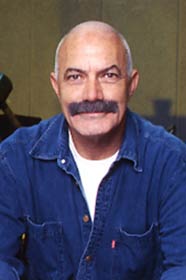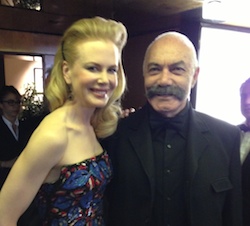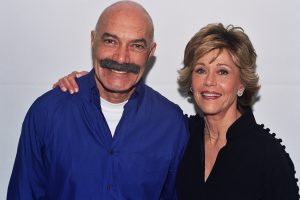Three of Hollywood’s hottest actors today, Johnny Depp, Billy Murray and Sarah Jessica Parker, starred in one of Tim Burton’s most charming films, “Ed Wood,” a laudatory, fictionalized tribute to a filmmaker who still bears the reputation of “Hollywood’s worst director.”
“Ed Wood” won two well-deserved Oscars: Supporting Actor for Martin Landau (at his third nomination) as Bela Lugosi, Wood’s aging, drug-addict star and spiritual mentor, and Makeup for Rick Baker, Ve Neill, and Yolanda Toussieng.
The film is a loving chronicle of the career of a Hollywood director responsible for some of the most hilariously inept movies ever made, including “Plan 9 from Outer Space” and the problem drama about transvestism, “Glen or Glenda.” Slight but amusing, “Ed Wood” offers an affecting portrait of a creative man who operated in the Hollywood’s fringes. Scott Alexander and Larry Karaszewski’s script is short on plot but full of atmosphere and amusing anecdotes.
Critics loved the movie, but audience stayed at home, and the movie died at the box-office (it’s one of Burton’s few commercial failures). In his Oscar acceptance speech, Landau quipped that everyone who saw the film must have been in the audience at the Oscar ceremonies at the Shrine Auditorium.

Production designer Tom Duffield talks about the film’s overall visual design in a feature titled, “Pie Plates Over Hollywood,” and there’s a fascinating discussion of the use of the musical instrument theremin by the film’s composer, Howard Schore. The edition also includes a strange black-and-white music video, the film’s theatrical trailer, and audio commentary with director Burton, actor Landau, the two writers, lenser Stefan Czapsky, and costume designer Colleen Atwood.
Burton places Wood in the context of Hollywood in the 1950s. Wood’s milieu existed in the shadows of the major studios and was populated by colorful and eccentric characters (real weirdoes). Wood’s entourage includes the aspiring effeminate transsexual Bunny Breckinridge (Bill Murray), the “amazing” TV psychic Criswell (Jeffrey Jones), TV horror hostess Vampira (Lisa Marie), actress Loretta King (Juliet Landau), and a new girlfriend, Kathy O’Hara (Patricia Arquette), who later became his wife
Wood was known for shooting movies quickly on miniscule budgets. His other claim to fame was that, although straight, he was an avid transvestite with a particular taste for Angora sweaters. This was dramatized in “Glen or Glenda,” in which Wood himself starred as a man seeking (in vain) to understand his odd habit.
The film begins with a most original credit sequences, in which the cast members’ names appear on tombstones. Wood (Depp) is then heard saying, “Orson Welles was only 26 when he made ‘Citizen Kane’ and I’m already 30,” realizing how urgent it is for him to make a personal feature. He chooses “I Changed My Sex,” loosely based on Christine Jorgensen’s sex change, and later retitled “Glen or Glenda.”
Wood secured financial backing by using Bela Lugosi, the old “Dracula” star. “I’m just an ex-boogeyman,” admits Lugosi (Landau), who hasn’t worked in years and is now addicted to morphine. Living in a dismal tract house, Lugosi is grateful for the work and becomes a spiritual mentor to Wood. By contrast, Wood’s girlfriend, a bad actress named Dolores Fuller (Parker) detests his weird colleagues.
Burton recreates with love the disrupted shoots of “Bride of the Monster” and “Plan 9,” taking pains to reproduce the flat look of Wood’s films. The production details of these works are amusing. After getting the cameras rolling, Wood signs off on every setup after only one take, regardless of how good it is.
The story’s central emotional core resides in the peculiar but touching relationship between Wood and Lugosi. Wood treats the old star with respect, and when Lugosi needs help with his addiction, he checks him into a clinic. Lugosi’s posthumous appearance was in “Plan 9.” Looking and sounding like Lugosi, Landau brilliantly conveys the pride, hurt and gratitude of an actor at the end of his life.
The film portrays a fictional encounter between Wood and his hero, Orson Welles (Vincent D’Onofrio). When a despondent Wood complains to Welles about his problems, he is told to tenaciously follow his own vision. “Visions are worth fighting for,” Welles insists, inspiring Wood to finish the shoot of “Plan 9.” D’Onofrio, a dead-ringer for Welles, is given a wonderfully nasty line, when Welles laments the fact that Universal has forcing him to cast Charlton Heston as a Mexican in “Touch of Evil.”

This and other flights into fantasy enrich the texture of the film, which is really not a biopicture. Hence we see Wood and his wife as they arrive at the prestigious Pantages Theater for the premiere of “Plan 9,” cheered by a full house. Burton goes out of his way to give Wood the artistic e recognition he sought but never achieved; Wood’s career eventually degenerated into pornography and alcoholism.
Technically, the black-and-white “Ed Wood” is a highly accomplished production. Tom Duffield’s production design conjures up a seedy rather than glamorous Hollywood, and cinematographer Stefan Czapsky, who should have been nominated for an Oscar, deserves special kudos for the double feat of reconstructing the laughably poor lighting of Wood’s disreputable films while at the same time shooting a luminous Tim Burton picture.










